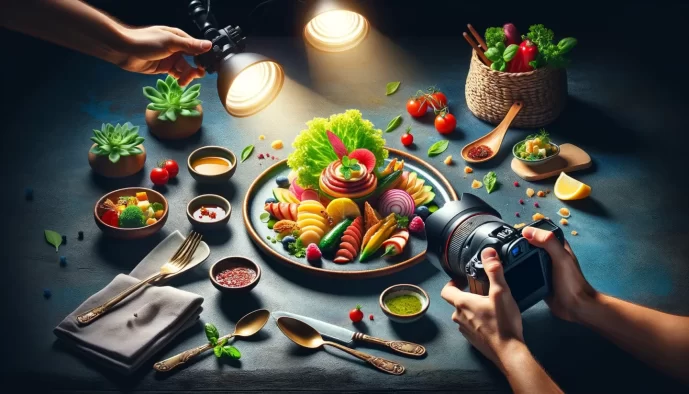Food Photography
Perfect your food snapshots with expert lighting, angle, and styling tips.

Introduction to Food Photography
Importance of Food Presentation
In the realm of food photography, the adage "we eat with our eyes first" reigns supreme. A dish’s visual allure can seduce the palate before a single taste. The artistry of cuisine presentation is integral, transforming a meal from mere sustenance to a feast for the senses.
The Objective of Food Photography
The objective is to evoke the sensory experience of food. It’s not just about snapping what’s on the plate, it’s about telling a story, conveying a lifestyle, or illustrating a culinary concept with visual allure that captivates the viewer.
Essential Equipment
Choosing the Right Camera
For food photography, a camera with manual controls and the ability to shoot in RAW is paramount. Whether a full-frame DSLR or a nimble mirrorless, it must offer precision and flexibility.
Lenses for Food Photography
Prime lenses with wide apertures, like a 50mm f/1.8 or a 100mm macro, are the stalwarts of food photography, delivering sharpness and a pleasing depth of field that accentuates the subject.
Tripods and Stabilization Tools
A reliable tripod is non-negotiable. It steadies the shot and frees the photographer to finesse the arrangement. Cable releases or remote shutters eliminate camera shake for impeccable clarity.
Lighting and Reflectors
Lighting is the linchpin. Quality diffusers and reflectors manage light and shadow, sculpting the food’s appearance with intention. The right setup breathes life into the image.
Setting the Scene
Selecting Backgrounds and Surfaces
Backgrounds and surfaces should complement, not compete. Neutral tones and textures—think reclaimed wood or marble—can elevate a dish without overpowering it.
Using Props Effectively
Props are narrative tools. They should resonate with the cuisine’s context, enhancing the story without cluttering the frame. Every spoon, napkin, or herb sprig is a deliberate choice.
Composition Techniques
Mastering the rule of thirds, playing with leading lines, and understanding the power of negative space are crucial. Composition is the silent narrator of your food story.
Lighting for Food Photography
Natural vs. Artificial Light
Natural light, with its soft gradients and authenticity, is ideal but fickle. Artificial light offers control and consistency. The preference hinges on the desired mood and setting.
Controlling Shadows and Highlights
Shadows add depth; highlights imply freshness. Manipulating both with diffusers, reflectors, and flags allows for a dynamic range that can mimic the complexity of flavor.
Color Temperature and Mood
Warmth invites; coolness refreshes. Color temperature shapes the emotional response to food, and a grasp of this can switch the ambiance of the image from cozy to crisp.
Styling and Arrangement
Tips for Plating and Presentation
Simplicity is key. Highlight the main ingredient, build height for interest, and ensure each element has space to breathe. A dish should be as architecturally sound as it is appetizing.
Textures and Layers
Textures tell tales of crunch, zest, or richness. Layers offer a visual taste of the complexity within. Together, they’re the secret to a photograph that’s almost palpable.
The Role of Color in Food Photography
Color is the siren call to the appetite. Complementary colors make dishes pop, while analogous schemes offer harmony. Balance is essential—let the color wheel be your guide.
Post-Processing Techniques
Basic Editing Steps
Post-processing starts with culling and basic adjustments. Exposure, white balance, and sharpness are the foundations of a well-edited food photograph.
Enhancing Colors and Contrast
Vibrancy and contrast adjustments can make an image sing, but beware the siren song of over-saturation. Realism in food photography should never be sacrificed on the altar of intensity.
Retouching Imperfections
A light touch is required. Retouching should be invisible, erasing distractions without leaving a trace. It’s the finesse of the final garnish.
Sharing and Monetizing Your Work
Building an Online Portfolio
An online portfolio is your digital storefront. It should be curated with intention, showcasing not just your best work, but your breadth and depth as a photographer.
Social Media and Marketing
Social media is the megaphone for your art, but your voice must be authentic. Engage genuinely, share with intention, and remember that quality trumps quantity.
Selling Food Images and Licensing
The market for food photography is vast, from stock image libraries to bespoke commissions. Know your worth, understand licensing, and always protect your intellectual property.
This guide is merely the appetizer in the lavish banquet of food photography. Devour each technique, practice with persistence, and your images will soon have viewers salivating for a taste of your talent.